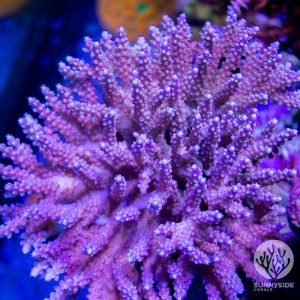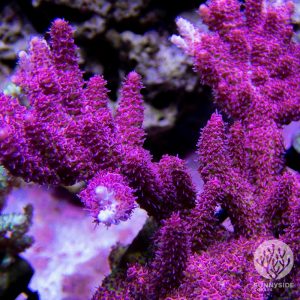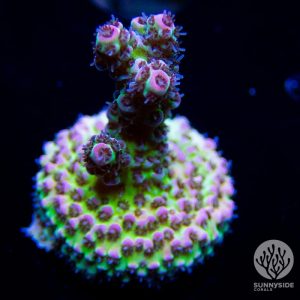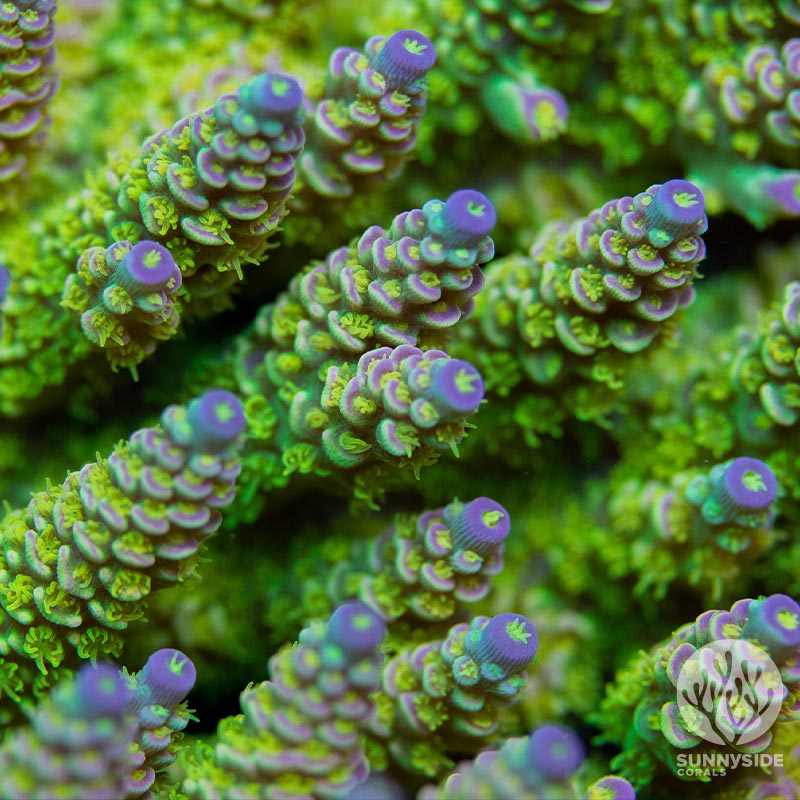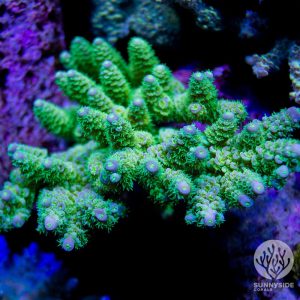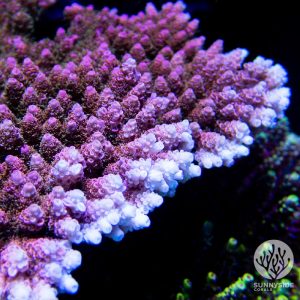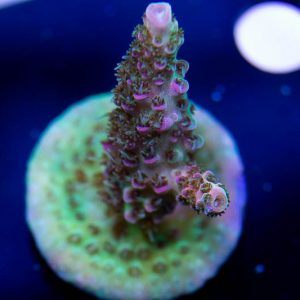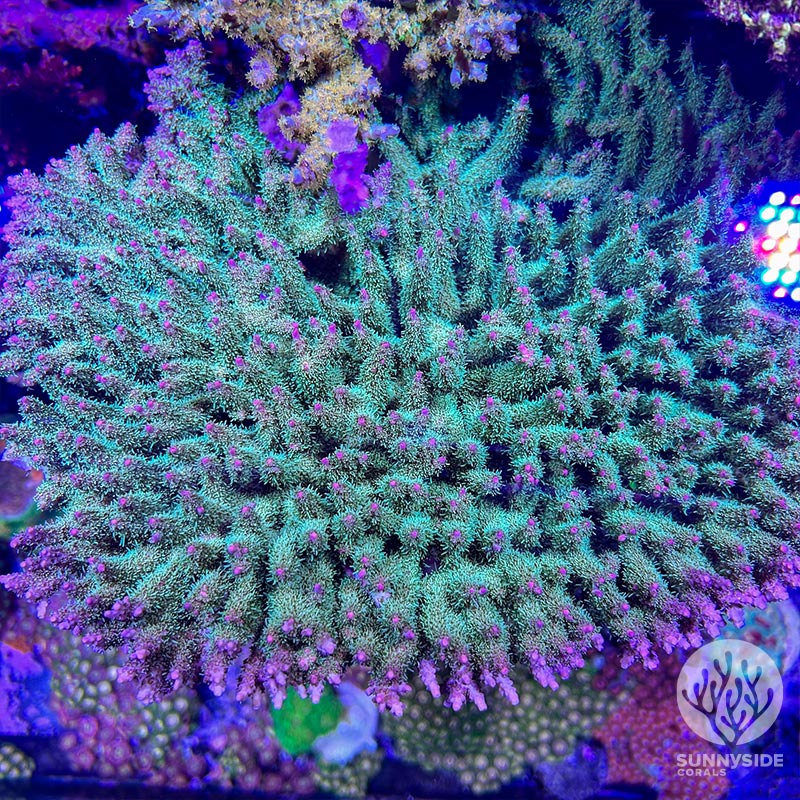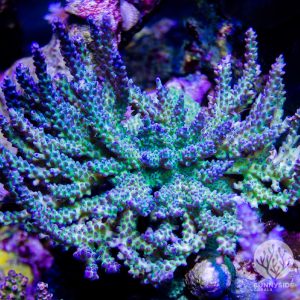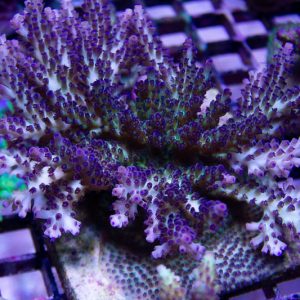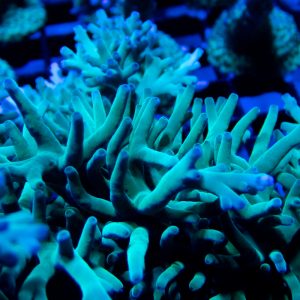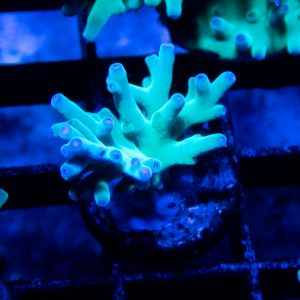Acropora are one of the most well-known types of coral and are definitely a favorite here at Sunnyside Corals! Known for their ‘stick’ like appearance and gorgeous coloring, acros are the envy of any tank. However, growing acros is definitely not for the faint of heart and not for new tanks. They are known to be an aggressive coral and can be a little bit of a challenge to grow and keep happy. That being said, while we may not recommend them for beginners, once your system is well established, acros are not as hard as some make them out to be. For those who are ready to get started growing Acropora, here is an intro to everything you need to know about Acropora coral care.
What are Acropora Corals?
Acropora are a genus of Small Polyp Stony corals (SPS) and often are referred to as “Acros” or “Sticks”. They are known to be one of the primary reef building corals and can be found in the reefs of islands such as; Fiji, Tonga, and the Great Barrier Reef. Acros grow hard carbonite skeletons and have rigid structures; and they are also covered in small little polyps that they use to absorb nutrients and food.
We have a large variety of Acropora here at Sunnyside Corals and each comes with its own little personality. Poletti’s Yellow Tip tends to be a little easier to keep, while High-End Tenuis like BigR Walt Disney can prove to be a little bit more challenging. This is because Poletti’s Yellow Tips are hearty and fast-growing. They also have been aquacultured for many many years. High-end Tenuis colonies on the other hand are touchy and can be very temperamental. Despite their challenges, acros are a very rewarding coral to keep when you get their setup just right. That being said, it is best to start with some of the easy SPS (such as monti, digi, and birds nest), then move into easy acros before stepping into some of the harder, high-end acros. You can always take out some of those easy corals laters and make room for the more challenging ones once you are more established.
Acropora Coral Care
How we manage our systems
Acros are very sensitive to water chemistry and are also very demanding in regards to lighting and flow. So much so that their coloration can change from tank to tank because of the slight differences in their systems. No need to worry though. You can find the right color with appropriate adjustments to your system and a little patience.

How much light do acros need?
Acropora are one of a few types of coral that are truly light-loving. Because of this, quality lighting is extremely important for growing Acropora and getting good coloration. At Sunnyside Corals, we grow all of our corals under both T-5 lighting and Radions. We run our lighting on a modified AB schedule with our T-5s and Radions. Our acros sit near the top of our tanks to assure that they are getting as much light as possible. We do not have a par meter but most people recommend that your acros sit at around 200 – 300 par lighting. Be aware that more damage can be caused by overexposure to light than not providing enough lighting. Be patient and take a couple of weeks to let your acros adjust to the lighting conditions in your tank to avoid potential harm. For more help on lighting, you can see our exact light set up and schedules on our tank lighting post.
Flow Requirements
Part of the variation of growth structures comes from the amount of flow your acros are getting. A stronger, high level flow will grow thicker, denser acros than in tanks with less flow. The growth of your colony in relation to the flow also plays a part in their nutrition. That being said, Acropora, in general, requires a high amount of flow. When placing your coral in your tank, make sure that you place it close to a pump to assure it is getting the optimal amount of flow. Do not forget to vary the amount of flow in your tank throughout the day. This helps promote healthy growth and is closer to their natural environment.
We like to run the flow in our tanks high. For our 200 gal display tank we run about 125x using 5 Mp40 Ecotech pumps along with a small non variable speed in the bottom back corner of the tank. In comparison, our 4×6 ft frag tank runs on the same system but uses 3 Mp40 pumps on one side that runs flow above the frags while the other side runs 2 Maxspect XF280 Gyre pumps; which rake across the bottom under the racks. All our pumps run on a varied schedule that dips down at night – to about 15%- and runs on a combo of reef crest and tidal flow during the day -at about 60%. However, we do run our pumps for a couple hours on full blast around noon for nutrient export. All of our pumps are placed strategically in our tanks to allow for good flow without directly hitting any of our corals.
There are two final things to take into account when it comes to flow performance in your tank. The first is the growth of the colony itself. Large colonies will cut down the flow and should be accounted for when setting up your flow levels. The second thing is that other organisms grow around your pump so it is important to keep up on regular maintenance and cleaning.
How to place Acropora
Make sure to place your acros close to the top of your tank or directly under a light so that it is receiving the most light possible. It is also a good idea to place pumps where they can directly blow on your acros to ensure they are getting a large amount of flow. Acros need room to grow so do not overcrowd them. This will also limit the amount of flow that they can receive which may stunt growth or make them unhappy.
How to feed Acropora
Acropora benefits from a regular feeding schedule for both growth and coloration. Unlike some corals, Acropora does not respond well to target feeding. Most often they will retract their polyps and start to excrete slime and filaments to protect themselves. There are three great options when it comes to food sources for your acros. The first are amino acids which provide protein. The second is small zooplankton; and the third is simply having fish present. For some reason, a higher volume of fish seems to positively impact Acropora. One idea being that they provide a good nitrogen source. Like with all other corals, it is important not to overfeed or you might develop algae or cyanobacteria. One sign of overfeeding is an elevated nitrate level.
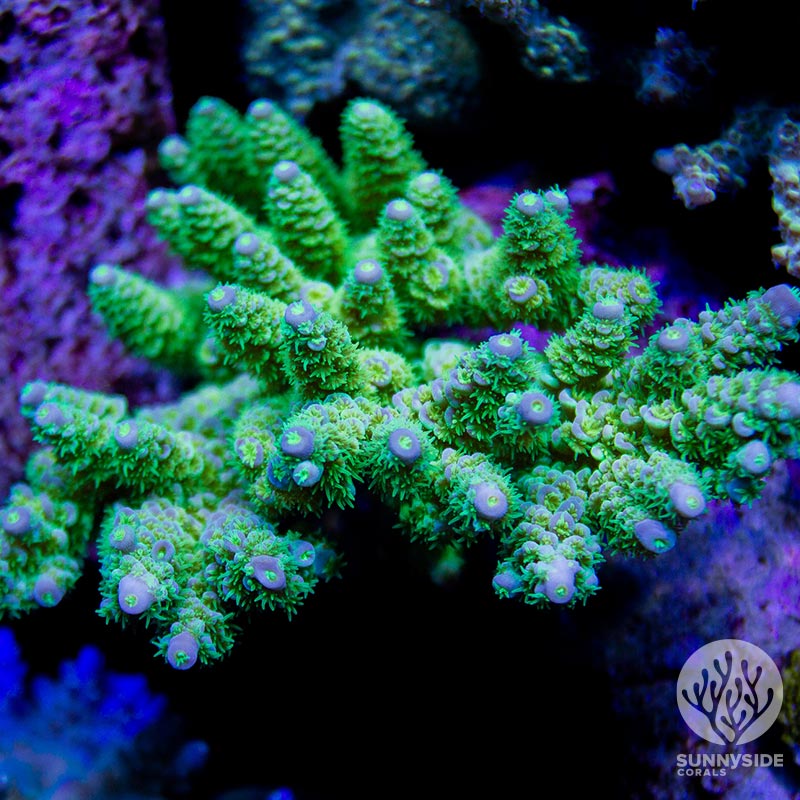
We aim to feed as heavy as we can without creating an algae problem. We keep fish in all our systems and feed with a very large variety of foods. We use automated pellets to set our baseline and supplement that at random with a variety of frozen foods. Some of those include: LRS reef frenzy frozen food (pe calanus), Hikari (spirulina brine shrimp), and reefroids and benepets. We will also use nori and flake food occasionally. There’s no set feeding schedule, but typically we’ll supplement with frozen once a week, then a few days later we might use powder and then a few days laters do flakes/ nori. Occasionally we also dose with aminos. All of this is based on our current algae levels. If algae levels are high then you are overfeeding. One thing to note is that once you get a fully mature acro tank, you can feed very heavy without seeing an impact.
Water Parameters
Water parameters are key to keeping acros alive and growing. Acros do well when run in a “clean tank” meaning shoot for next to zero Phosphates and Nitrates. The most important thing though, is that you keep your levels stable. If your parameters start to fluctuate or spike, you could stunt the growth or even kill your acros. Because of this, adjustments should be done carefully, over time. It may take a couple weeks, to as long as a couple months to make necessary adjustments.
Maintaining levels is tricky. There are 3 major chemical parameters that need to be monitored for a successful Acropora filled tank: calcium, alkalinity, and magnesium. It can be difficult to make adjustments to your calcium and alkalinity because of how they react to each other. An increase in calcium may cause a fall in alkalinity levels. A way to balance these two is with the use of magnesium IF you are unable to make the necessary changes to your calcium and alkalinity first. Look into automation tools such as dosers, refugium, and calcium reactors to help stabilize your tank levels. We aim to keep very standard levels in our systems.
ALK: 9
CAL: 420
MAG: 1400
Salinity: 1.025
We also use automation tools to help keep these levels stable. Our two main acro systems utilize large, commercial grade calcium reactors. We run a KALK reactor to keep ph up on both systems and we run a zero mag in the calcium reactors to keep the magnesium stable
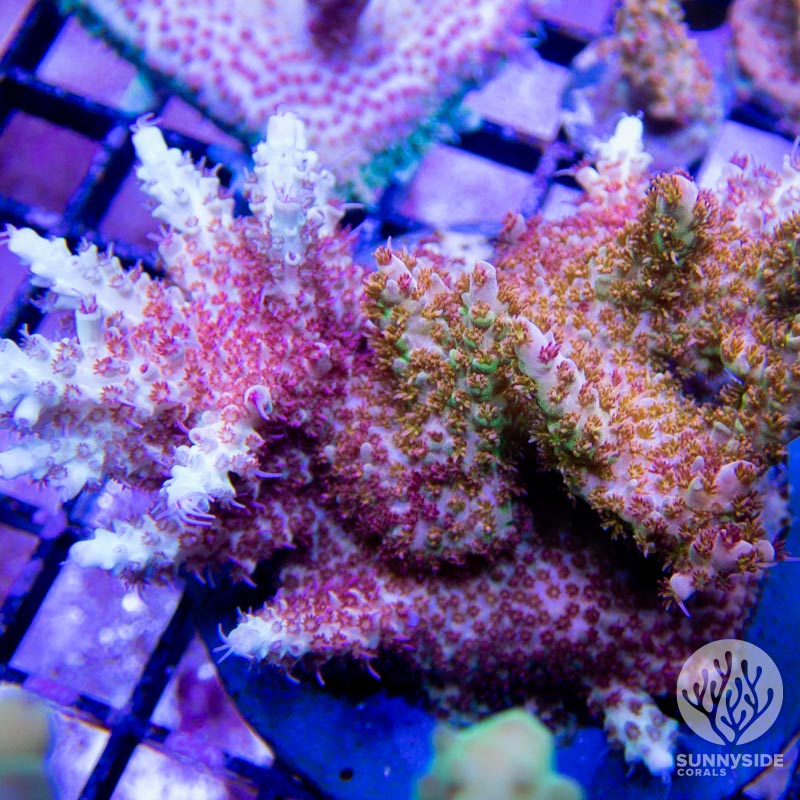
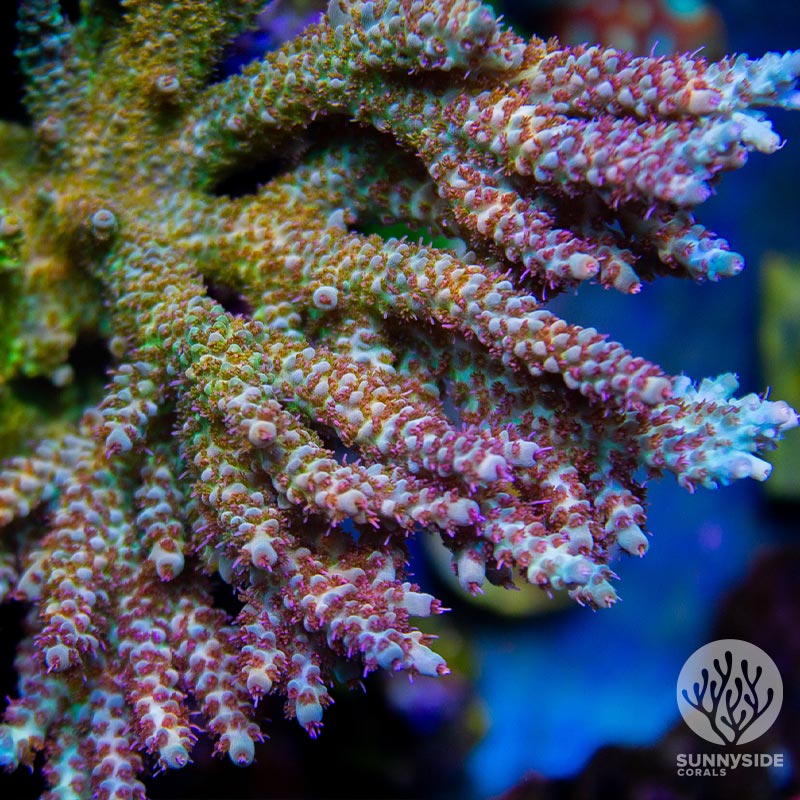
How to increase Acro Growth
The key to increasing Acropora growth in your tank is to make sure your tank is consistent. Once you find a spot in your tank where your corals are happy, don’t move them. If you keep your parameters consistent and have adequate light and flow, your corals will start to thrive.
How to handle Acropora aggression
Acropora is known as an aggressive coral because of its powerful sting. This sting can be especially harmful to SPS corals growing around them and can even kill off part of the coral. An easy way to avoid future problems is to think ahead with your placement. Make sure to give them plenty of room to grow. As your acro grows, consider fragging your acropora to avoid it touching other SPS corals. Fortunately, tank mates are less of a concern as Acropora corals can be kept with any reef-safe species. Some of the fish we love to include with our acros are, tangs, wrasse and damsels; which are all great tank maintenance fish. Some algae grazers we also like to add are fox face and lawnmower blennies. As a side note, springer damsels are better in frag tanks as they won’t jump. Wrasse will jump.
Diseases and pests to look out for
Acros are susceptible to various pests and diseases; such as ‘red bugs’ and flatworms. These pests can cause your acros to lose color and can even kill off part of your coral. Because of this, Sunnyside Corals has had a multi-step dipping process in place for years. All of our new corals go through this process and then are added to a temporary quarantine tank before being placed in any of our other tanks.
Things to Know Before You Buy Acropora:
Acropora corals are not for everyone. Thankfully as technology advances, acros have become increasingly easy to take care of. Once you get your system running smoothly and it is stable you can grow acros fairly easily. Things like dosers, calcium reactors and other automated tools have made keeping Acropora a lot easier once you have everything set up. It is not completely hands-off though and does still require more attention than other types of coral.
Other important factors that play a role in the success of growing Acropora are the correct amount of lighting and flow. At Sunnyside Corals, we run a modified AB schedule with Gen 4 radions and supplement T-5 lighting on all our corals. Our acros grow best under high amounts of light. We do not have a par meter but typically it is recommended to keep around 300 par. Typically at the top of your tank are the best spots.
Overall acros are a great choice and can be very rewarding. Some acros are touchier than others as well as have different growth rates. Please be aware of the needs of the specific type of acro when buying.
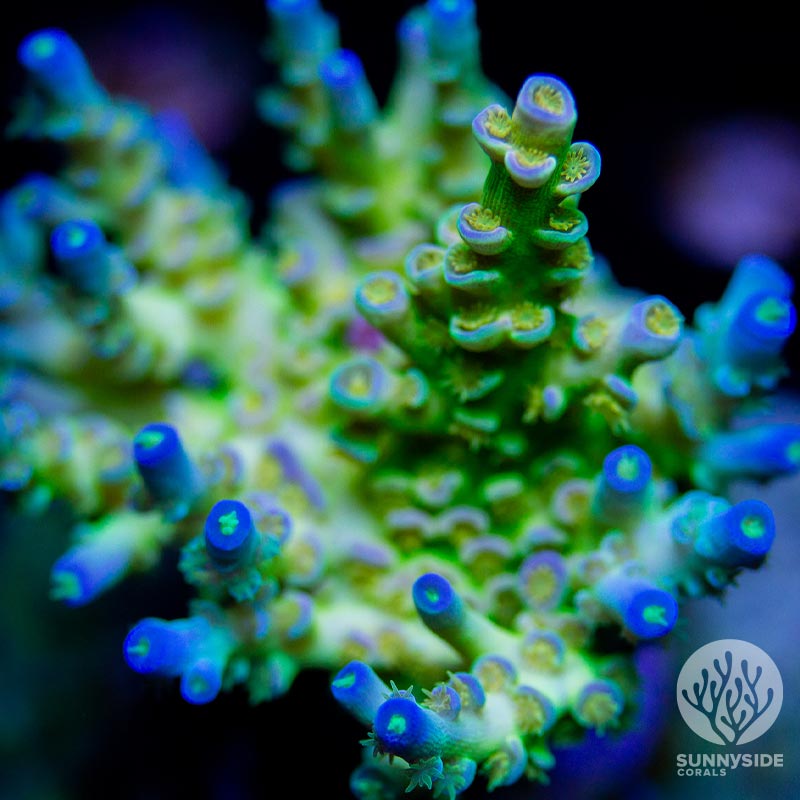
When can I add Acropora to my tank?
Acropora can be one of the touchiest corals to grow. They require a stable system with very little fluctuation in water parameters and temperature. Because of this most tanks typically need to be close to a year old before you start to add acros. You need to give your tank enough time to stabilize in order to be successful in growing Acropora.
Dry Rock
If you started your tank with dry rock you will most likely have to wait close to 12 to 18 months before you will be able to successfully keep acros alive. This is because dry rock can leach phosphate into the water for a very long time. Acros typically do best with next to zero Phosphate and Nitrate levels.
Live Rock
If you started your tank with live rock that process can be dramatically shorter. However, be aware that just because your levels are where they should be, does not mean that your tank is actually ready for any corals. We recommend introducing LPS or Soft corals first with any new system. After having success with LPS and soft coral for a while you can begin to introduce easy SPS corals like montis. Acros should be the last thing you try to add to your system
Acropora FAQs
What is Acropora corals?
Acropora is a genus of Small Polyp Stony corals (SPS) and is often referred to as “Acros” or “Sticks”. They grow hard carbonite skeletons and have rigid structures. Acros are covered in small little polyps that they use to absorb nutrients and food.
Can Acropora touch each other?
Most Acropora can touch and often will stop growing in that direction once they start to touch.
Can bleached Acropora recover?
When Acropora bleach it is often due to temperature swings. Your Acropora may recover from bleaching if they are left alone in ideal circumstances but, this is not always the case.
How do I know if my Acropora coral is healthy?
Some key indicators that your Acropora coral is healthy include polyp extension, healthy coloration, and new growth. Sometimes corals will go through a phase where they do not grow as much but as long as your acro still has good polyp extension and good coloration, your acro should eventually start growing again.
How to acclimate Acropora?
Acclimating new Acropora can increase the rate of survival. It only takes a few minutes to do and is well worth it.
1) While still in the bag, place your coral inside of your tank to float for 10 minutes. This allows the water temperature in the bag to become consistent with your tank water.2) Remove your coral from the bag and place the coral and the water inside in a clean bucket designated for aquarium use.
3) Fill your bucket with 50% water from your tank and 50% water from the bag. (use all of the water from the bag)
4) Now is the perfect time to treat your coral with a coral dip in order to get rid of any unwanted hitchhikers.
5)After dipping and rinsing off your coral, you can place your coral in your tank. We recommend placing corals lower in your tank and moving them up slowly to find a happy spot in your tank. Every coral on our site has instructions on recommended placement requirements. Please, refer to the product page for specific requirements.
How to dip Acropora?
Most coral dips are too potent and often kill or stress out Acropora, especially smooth skins. We recommend that you use Bayer Advanced Complete Insect Killer when dipping Acros. It does the best job with the least amount of harm to your corals in our experience.
What causes Acropora to bleach?
The main cause of Acropora bleaching is an increase in water temperature.
When to add Acropora?
Acropora requires a very established tank in order to survive because of their sensitivity to fluctuations. We often recommend that hobbyist wait up to a year before starting to add Acropora to their tanks.
Are Acropora hard to keep?
Acropora is known to be one of the more difficult corals to grow and keep happy. But truth be told, once your system is well established, acros are not as hard as some make them out to be. For those who are ready to get started growing Acropora, here is an intro to everything you need to know about Acropora coral.
Where to place Acropora?
Make sure to place your acros close to the top of your tank or directly under a light so that it is receiving the most light possible. It is also a good idea to place pumps where they can directly blow on your acros to ensure they are getting a large amount of flow. Acros need room to grow so do not overcrowd them. This will also limit the amount of flow that they can receive which may stunt growth or make the acros unhappy.
Why does my Acropora have white tips?
White tips on Acropora mean that your coral is either starting to die or it just has new growth. Any Acropora that starts to develop white tips should be watched closely for any sign of deterioration.
